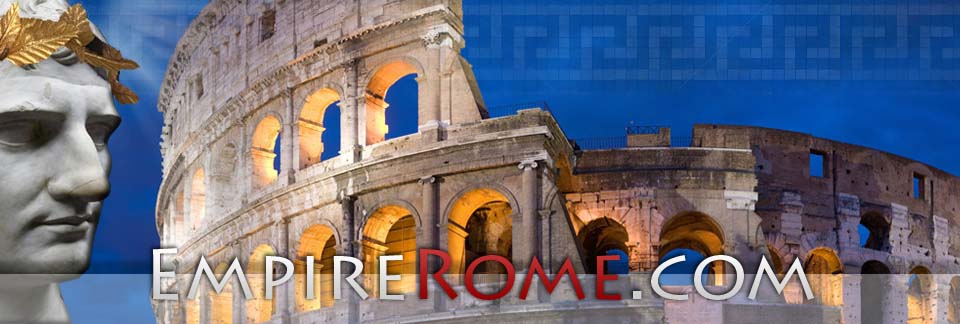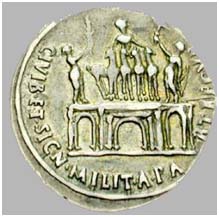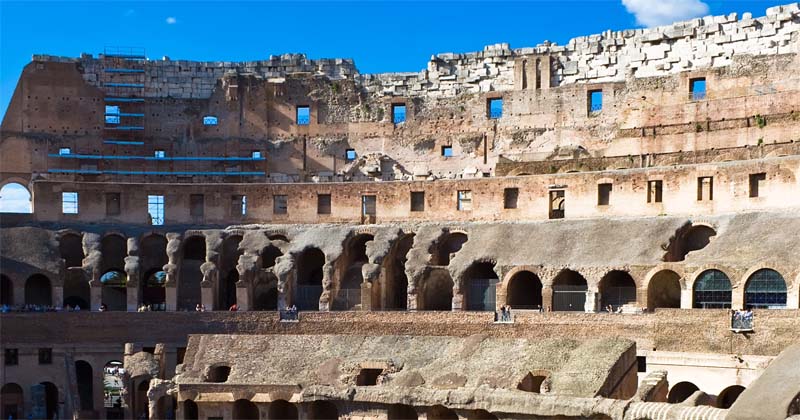
Arches were an architectural invention used throughout the Ancient Roman Empire. Arches were used for their stunning visual design and more importantly to create support for many of Ancient Rome’s buildings and monuments. The most notable structure in Ancient Rome that used arches were the Ancient Roman aqueduct systems. The aqueduct systems were used to bring fresh water to cities throughout the Ancient Roman empire. Roman arches were also used to construct the famous Roman Colosseum where many gladiators and Roman events were held to entertain citizens.
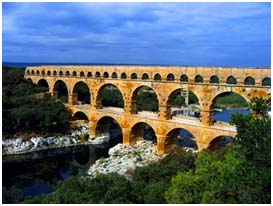 Arches were also used in Roman buildings because of their strength and support capabilities. Because of the curved design of the arch, it allows structures to pass weight from above, down to the ground through piers that support the arch. Additional forms of arches are vaults and a barrel vaults. A vault is a long arch that makes massive structures possible. These types of arches allowed the Ancient Romans to build massive buildings compared to traditional masonry techniques that were limited and were not able to withstand a huge amount of weight. Barrel vaults were used in Ancient Roman bathhouses because of their strength and structure properties. Unlike traditional masonry with wood roofing, these barrel arches were resistant to decay, humidity, and weather. This was ideal for bathhouses of that time era.
Arches were also used in Roman buildings because of their strength and support capabilities. Because of the curved design of the arch, it allows structures to pass weight from above, down to the ground through piers that support the arch. Additional forms of arches are vaults and a barrel vaults. A vault is a long arch that makes massive structures possible. These types of arches allowed the Ancient Romans to build massive buildings compared to traditional masonry techniques that were limited and were not able to withstand a huge amount of weight. Barrel vaults were used in Ancient Roman bathhouses because of their strength and structure properties. Unlike traditional masonry with wood roofing, these barrel arches were resistant to decay, humidity, and weather. This was ideal for bathhouses of that time era.
Aside from incorporating arches for their structural support properties, arches were also used because of their beauty and architectural advantages. Arches were integrated with components of Greek architectural traits because of their beautifying properties. These traits consisted of: columns, capitals, architraves, and pediments. Many of these architectural techniques can be found throughout the Ancient Roman and Ancient Greek buildings. It was the Ancient Romans who truly took advantage of these architectural designs to adorn and beautify their monuments. Ancient Rome was an empire that adopted many of their building techniques and architectural traits they admired from people they conquered or came into contact with.
Ancient Roman builders and architects became so successful at building structures with arches, that before long, the empire was erecting buildings that would adorn the landscape. A famous example of this is the Colosseum. It should be noted that the Colosseum would probably be more intact today if it was not for stone robbers. This is largely a reason why the Colosseum appears so aged and damaged because it was robbed for stone in the middle ages.
Ancient Romans used arches in many of their structures, but they did not invent them. They originally came from the Etruscans who had a huge influence on Roman architecture as well as many other aspects of Roman rule. Etruscans were an early ancient civilization of ancient Italy around the area of Tuscany.
Triumphal Arches Used To Celebrate Victories of Wars
The Arch of Septimius Severus (Arco di Settimio Severo)
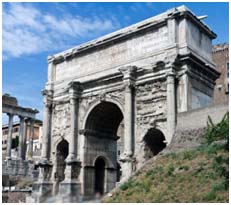 The Arch of Septimius Severus (Arco di Settimio Severo) was built in 203 AD. This arch is approximately 70 feet high and was constructed out of pentelic marble (white marble with grey veins), travertine base, and gilded bronze inscriptions. The Arch of Septimius Severus is located on Capitoline Hill and was built in honor of the two victories over the Parthians. Parthians is known today as areas in modern day Iraq and Iran. This arch is one of the most lavishly decorated arches of its kind with intricate designs, relief panels, sculptures, minor arches, and decorative columns.
The Arch of Septimius Severus (Arco di Settimio Severo) was built in 203 AD. This arch is approximately 70 feet high and was constructed out of pentelic marble (white marble with grey veins), travertine base, and gilded bronze inscriptions. The Arch of Septimius Severus is located on Capitoline Hill and was built in honor of the two victories over the Parthians. Parthians is known today as areas in modern day Iraq and Iran. This arch is one of the most lavishly decorated arches of its kind with intricate designs, relief panels, sculptures, minor arches, and decorative columns.
The Arch of Septimius Severus was also built to commemorate Emperor Septimius Severus and his two sons; Caracalla and Geta. After Emperor Septimius died, the two brothers became joint rulers. Because of jealousy, Caracalla had his brother Geta killed in 212 A.D. and chiseled any reference of him from the famous Arch. Erasing a person from paintings, monuments, and inscriptions was known as damnatio memoriae or “damnation of memory, this was a form of shame used in Ancient Roman times.
In 219 A.D., Emperor Elagabalus restored Geta’s reputation. Elagabalus had Geta’s remains put in the Mausoleum of Hadrian to be with his father Septimius Severus and Carcalla.
Official restoration of Geta’s reputation came with the arrival of the emperor Elagabalus to Rome in 219, when Geta’s remains were put into the Mausoleum of Hadrian to join those of his father and brother.
The Arch of Titus (Arco di Tito)
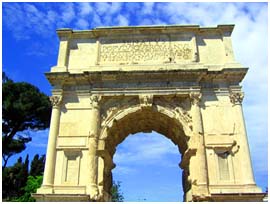 The Arch of Titus (Arco di Tito) was built in 81 A.D. This arch is approximately 50 feet high and was constructed out of Ancient Roman concrete, pentelic marble (white marble with grey veins), and bronze. The Arch of Titus is located at the Via Sacra on the eastern side of the forum. This arch is the oldest triumphal arch from Ancient Rome. The Arch of Titus was built to honor the victory of the Ancient Romans over the Jewish people in Judea. This event was the beginning of the Jewish displacement throughout Europe known as Jewish diaspora. The Jewish temple (the second temple) was destroyed and pillaged. Religious artifacts and treasures were plundered and taken back to Rome along with Jewish slaves.
The Arch of Titus (Arco di Tito) was built in 81 A.D. This arch is approximately 50 feet high and was constructed out of Ancient Roman concrete, pentelic marble (white marble with grey veins), and bronze. The Arch of Titus is located at the Via Sacra on the eastern side of the forum. This arch is the oldest triumphal arch from Ancient Rome. The Arch of Titus was built to honor the victory of the Ancient Romans over the Jewish people in Judea. This event was the beginning of the Jewish displacement throughout Europe known as Jewish diaspora. The Jewish temple (the second temple) was destroyed and pillaged. Religious artifacts and treasures were plundered and taken back to Rome along with Jewish slaves.
The Arch of Titus was erected after the death of Titus by the Emperor Domitian. Domitian was Titus’ younger brother. Vespasian began to suppress the Jewish revolt in Judea and Titus’ attack ended the Jewish Wars. Vespasian was the father of Titus and Domitian. The arch was erected to honor Vespasian and Titus and commemorate their victories of the Siege of Jerusalem in 70 A.D.
Arch of Tiberius (Arcus Tiberi)
Built in 16 A.D., not much is known about this arch. The Arch of Tiberius was built to celebrate the victory over the Germanic Tribes; although not directly a victory of Tiberius. These battles took place in order to recover the eagle standards which had been lost to the Germanic Tribes in previous battles. The Eagle Standards were (banner/flag bearing the Ancient Roman Military’s emblem) recovered by an Ancient Roman general named Germanicus. The Arch of Tiberius was dedicated to the emperor Tiberius because during the Imperial period only the emperor could celebrate a Triumph.
Arch of Augustus
The Arch of Augustus was built in 29 B.C. and was dedicated to Augustus by the Ancient Roman Senate. This arch marks the victory of Actium in 31 B.C. against Anthony and Cleopatra. Little remains of the arch; however, depictions are seen from coins of that area. The Arch of Augustus shows three arches and a bronze statue that sat atop of the arch. It should be noted that this arch is one of the oldest arches and the first arch in Ancient Rome and lead the way for others to be built throughout the empire.
Arch of Constantine (Arco di Costantino)
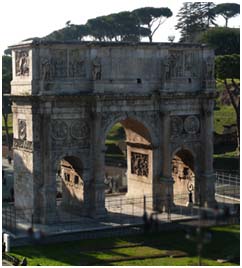 The Arch of Constantine (Arco di Costantino) was built in 315 A.D. and was dedicated by the Ancient Roman Senate. This arch is approximately 85 feet tall and is located between the Colosseum and the Palatine Hill. This arch was built by reusing many parts from earlier buildings and monuments as this was a common practice at the time. The Arch of Constantine was built to commemorate the victory during the Battle of Milvian Bridge where Constantine I triumphed over Maxentius.
The Arch of Constantine (Arco di Costantino) was built in 315 A.D. and was dedicated by the Ancient Roman Senate. This arch is approximately 85 feet tall and is located between the Colosseum and the Palatine Hill. This arch was built by reusing many parts from earlier buildings and monuments as this was a common practice at the time. The Arch of Constantine was built to commemorate the victory during the Battle of Milvian Bridge where Constantine I triumphed over Maxentius.
Roman Aqueducts
Aqueducts were used throughout Ancient Rome to bring water to their thriving cities. The population of Ancient Roman cities grew tremendously and so did the need for water. The first Ancient Roman aqueduct was built in 312 B.C. These aqueducts were built by using high arches and pillars on a gradual grade to bring water into the city.
Aqueducts were essential in making Ancient Roman cities thrive, without water people would have to go elsewhere and disperse thought the country to survive, following sources of fresh drinkable water. With the use of aqueducts, people could stay in the same area, put down roots, continually build their cities and economies, create relationships, and have goods brought in to the cities. All of these positive aspects of the aqueducts made it possible for citizens to live a move constant life, not having to travel around where the water took them. Having a more permanent address helped these Ancient Roman cities flourish.
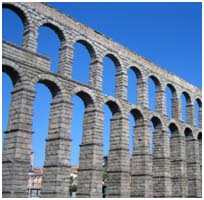
Three hundred million gallons of water were brought into Rome by 14 different aqueducts each day. Water in Ancient Rome was used for bathhouses and sewers. Water use of Ancient Rome rivaled that of today’s big cities. It should also be noted that aside from the ancient Egyptians, they were one of the first ancient civilizations to harness the power water and move it freely throughout the empire.
